#NGC 7715
Explore tagged Tumblr posts
Text
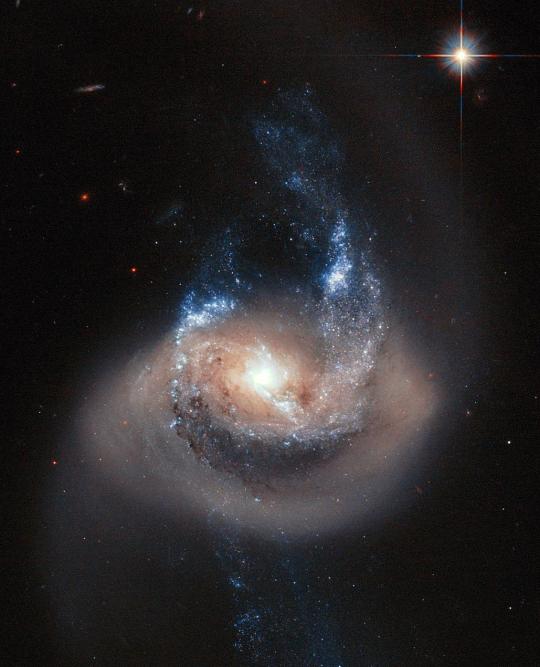
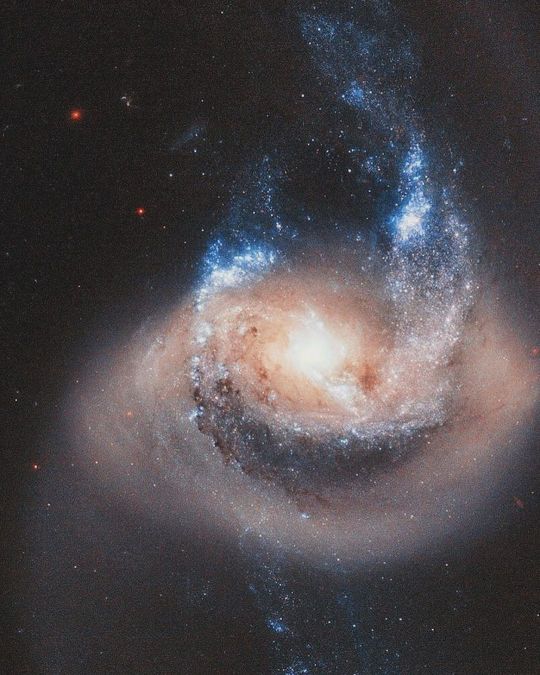

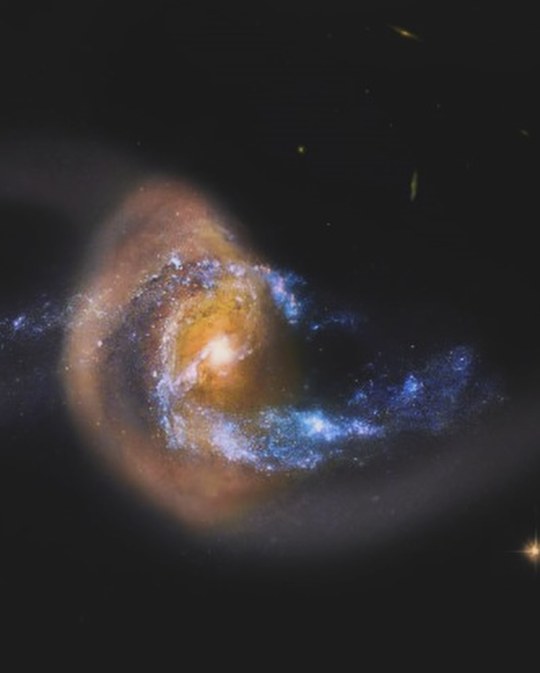
THE MASTER OF THE UNIVERSE CRUSHES ALL -- WHEN TWO GALAXIES COLLIDE.
PIC(S) INFO: Spotlight on a Hubble image of NGC 7714, a spiral galaxy 100 million light-years from Earth. 🔭+📸: ESA (European Space Agency) & NASA.
MINI-OVERVIEW: "NGC 7714 is a spiral galaxy 100 million light-years from Earth — a relatively close neighbour in cosmic terms.
The galaxy has witnessed some violent and dramatic events in its recent past. Tell-tale signs of this brutality can be seen in NGC 7714's strangely shaped arms, and in the smoky golden haze that stretches out from the galactic centre — caused by an ongoing merger with its smaller galactic companion NGC 7715..."
-- ESA HUBBLE, "Hubble image of NGC 7714," first published in 2015
Acknowledgement: A. Gal-Yam (Weizmann Institute of Science)
Sources: https://esahubble.org/images/heic1503a, Picuki, & X (formerly Twitter).
#NGC 7714#NGC 7715#Galaxies#Spiral Galaxy#Space is Deep#Galaxy Collision#Outer Space#Hubble Space Telescope#Space Telescope#Astrophotography#Hubble#Cosmic Forces#Astronomy#Deep Space#Colliding Galaxies#Hubble Telescope#Galaxy
48 notes
·
View notes
Text

This image of NGC 7714, taken by Hubble, shows the effect of an interaction between galaxies. An encounter with NGC 7715, which lies to the left, off frame, started a bout of star formation, seen in the blue arcs around this galaxy’s center: https://bit.ly/4cyLAjj
93 notes
·
View notes
Photo
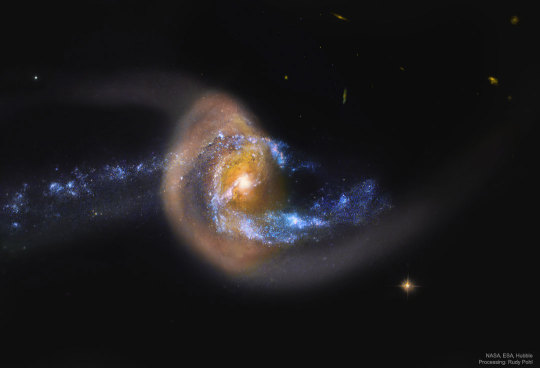
2024 March 17
NGC 7714: Starburst after Galaxy Collision Image Credit: NASA, ESA, Hubble Legacy Archive; Processing & Copyright: Rudy Pohl
Explanation: Is this galaxy jumping through a giant ring of stars? Probably not. Although the precise dynamics behind the featured image is yet unclear, what is clear is that the pictured galaxy, NGC 7714, has been stretched and distorted by a recent collision with a neighboring galaxy. This smaller neighbor, NGC 7715, situated off to the left of the frame, is thought to have charged right through NGC 7714. Observations indicate that the golden ring pictured is composed of millions of older Sun-like stars that are likely co-moving with the interior bluer stars. In contrast, the bright center of NGC 7714 appears to be undergoing a burst of new star formation. The featured image was captured by the Hubble Space Telescope. NGC 7714 is located about 130 million light years away toward the constellation of the Two Fish (Pisces). The interactions between these galaxies likely started about 150 million years ago and should continue for several hundred million years more, after which a single central galaxy may result.
∞ Source: apod.nasa.gov/apod/ap240317.html
90 notes
·
View notes
Photo

Arp 284: NGC 7715 (left) and NGC 7714 (right) // Gary Imm
#astronomy#astrophotography#galaxy#spiral galaxy#star-forming galaxy#interacting galaxies#peculiar galaxy#Arp 284#NGC 7715#NGC 7714#pisces
43 notes
·
View notes
Photo

NGC 7714 Collides With Smaller NGC 7715
#NGC 7714#NGC 7715#nasa#stargazing#astrophoto#astrophotography#galaxy#astronomy#universe#space#nebula#spinningblueball#milky way#milky way galaxy#star
78 notes
·
View notes
Photo
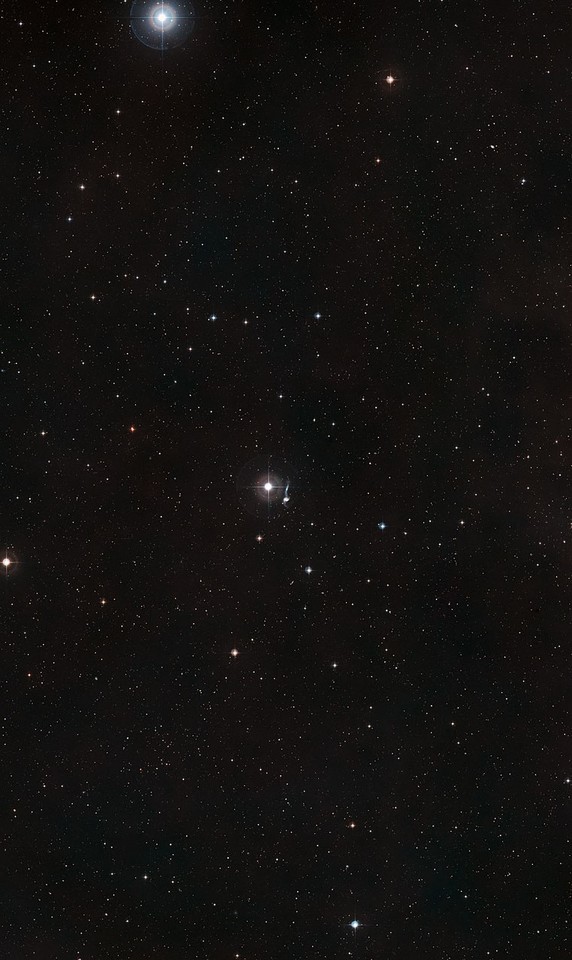
Distant Merger
46 notes
·
View notes
Text
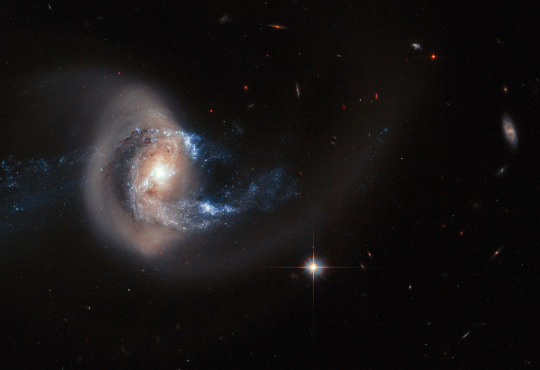
𝑵𝑮𝑪 7714
NGC 7714 is a spiral galaxy 100 million light-years from Earth — a relatively close neighbour in cosmic terms.
The galaxy has witnessed some violent and dramatic events in its recent past. Tell-tale signs of this brutality can be seen in NGC 7714's strangely shaped arms, and in the smoky golden haze that stretches out from the galactic centre — caused by an ongoing merger with its smaller galactic companion NGC 7715, which is out of the frame of this image.
61 notes
·
View notes
Photo

NGC 7714: Starburst after Galaxy Collision : Is this galaxy jumping through a giant ring of stars? Probably not. Although the precise dynamics behind the featured image is yet unclear, what is clear is that the pictured galaxy, NGC 7714, has been stretched and distorted by a recent collision with a neighboring galaxy. This smaller neighbor, NGC 7715, situated off to the left of the featured frame, is thought to have charged right through NGC 7714. Observations indicate that the golden ring pictured is composed of millions of older Sun-like stars that are likely co-moving with the interior bluer stars. In contrast, the bright center of NGC 7714 appears to be undergoing a burst of new star formation. The featured image was captured by the Hubble Space Telescope. NGC 7714 is located about 130 million light years away toward the constellation of the Two Fish (Pisces). The interactions between these galaxies likely started about 150 million years ago and should continue for several hundred million years more, after which a single central galaxy may result. via NASA
635 notes
·
View notes
Photo

NGC 7714: Starburst after Galaxy Collision via NASA https://ift.tt/2LXq8uK
Is this galaxy jumping through a giant ring of stars? Probably not. Although the precise dynamics behind the featured image is yet unclear, what is clear is that the pictured galaxy, NGC 7714, has been stretched and distorted by a recent collision with a neighboring galaxy. This smaller neighbor, NGC 7715, situated off to the left of the featured frame, is thought to have charged right through NGC 7714. Observations indicate that the golden ring pictured is composed of millions of older Sun-like stars that are likely co-moving with the interior bluer stars. In contrast, the bright center of NGC 7714 appears to be undergoing a burst of new star formation. The featured image was captured by the Hubble Space Telescope. NGC 7714 is located about 130 million light years away toward the constellation of the Two Fish (Pisces). The interactions between these galaxies likely started about 150 million years ago and should continue for several hundred million years more, after which a single central galaxy may result.
(Published October 09, 2019)
15 notes
·
View notes
Photo

Is this galaxy jumping through a giant ring of stars? Probably not. Although the precise dynamics behind the featured image is yet unclear, what is clear is that the pictured galaxy, NGC 7714, has been stretched and distorted by a recent collision with a neighboring galaxy. This smaller neighbor, NGC 7715, situated off to the left of the featured frame, is thought to have charged right through NGC 7714. Observations indicate that the golden ring pictured is composed of millions of older Sun-like stars that are likely co-moving with the interior bluer stars. In contrast, the bright center of NGC 7714 appears to be undergoing a burst of new star formation. The featured image was captured by the Hubble Space Telescope. NGC 7714 is located about 130 million light years away toward the constellation of the Two Fish (Pisces). The interactions between these galaxies likely started about 150 million years ago and should continue for several hundred million years more, after which a single central galaxy may result.
NGC 7714: Starburst after Galaxy Collision Image Credit: NASA, ESA, Hubble Legacy Archive; Processing & Copyright: Rudy Pohl
https://apod.nasa.gov/apod/ap191009.html?fbclid=IwAR2tZfVhxzZUxNofYXIOzfo1yH1IIsHVz5yf-kGUbq5wq6rxuJ_SfMML7b0
7 notes
·
View notes
Text
ARP 284 a Galactic Merger in Pisces
Here is a pair of galaxies from the Arp Atlas of Peculiar Galaxies, this one designated ARP 284 and showing the results of NGC 7714 and NGC 7715 interacting with each other causing a violent and dramatic change in both galaxy shapes. You can see the bridge of stars allowing material to transfer from the smaller galaxy to the larger one. The magnitudes of these galaxies are listed as 13 and 15 in…
View On WordPress
0 notes
Photo

NGC 7714: Starburst after Galaxy Collision via NASA https://ift.tt/2LXq8uK
Is this galaxy jumping through a giant ring of stars? Probably not. Although the precise dynamics behind the featured image is yet unclear, what is clear is that the pictured galaxy, NGC 7714, has been stretched and distorted by a recent collision with a neighboring galaxy. This smaller neighbor, NGC 7715, situated off to the left of the featured frame, is thought to have charged right through NGC 7714. Observations indicate that the golden ring pictured is composed of millions of older Sun-like stars that are likely co-moving with the interior bluer stars. In contrast, the bright center of NGC 7714 appears to be undergoing a burst of new star formation. The featured image was captured by the Hubble Space Telescope. NGC 7714 is located about 130 million light years away toward the constellation of the Two Fish (Pisces). The interactions between these galaxies likely started about 150 million years ago and should continue for several hundred million years more, after which a single central galaxy may result.
2 notes
·
View notes
Photo

2019 October 9
NGC 7714: Starburst after Galaxy Collision Image Credit: NASA, ESA, Hubble Legacy Archive; Processing & Copyright: Rudy Pohl
Explanation: Is this galaxy jumping through a giant ring of stars? Probably not. Although the precise dynamics behind the featured image is yet unclear, what is clear is that the pictured galaxy, NGC 7714, has been stretched and distorted by a recent collision with a neighboring galaxy. This smaller neighbor, NGC 7715, situated off to the left of the featured frame, is thought to have charged right through NGC 7714. Observations indicate that the golden ring pictured is composed of millions of older Sun-like stars that are likely co-moving with the interior bluer stars. In contrast, the bright center of NGC 7714 appears to be undergoing a burst of new star formation. The featured image was captured by the Hubble Space Telescope. NGC 7714 is located about 130 million light years away toward the constellation of the Two Fish (Pisces). The interactions between these galaxies likely started about 150 million years ago and should continue for several hundred million years more, after which a single central galaxy may result.
∞ Source: apod.nasa.gov/apod/ap191009.html
79 notes
·
View notes
Photo

NGC 7714: Starburst after Galaxy Collision Is this galaxy jumping through a giant ring of stars? Probably not. Although the precise dynamics behind the featured image is yet unclear, what is clear is that the pictured galaxy, NGC 7714, has been stretched and distorted by a recent collision with a neighboring galaxy. This smaller neighbor, NGC 7715, situated off to the left of the featured frame, is thought to have charged right through NGC 7714. Observations indicate that the golden ring pictured is composed of millions of older Sun-like stars that are likely co-moving with the interior bluer stars. In contrast, the bright center of NGC 7714 appears to be undergoing a burst of new star formation. The featured image was captured by the Hubble Space Telescope. NGC 7714 is located about 130 million light years away toward the constellation of the Two Fish (Pisces). The interactions between these galaxies likely started about 150 million years ago and should continue for several hundred million years more, after which a single central galaxy may result. October 09, 2019 via Space https://ift.tt/2LXq8uK
1 note
·
View note
Photo

NGC 7714 Collides With Smaller NGC 7715
#NGC 7714#NGC 7715#nasa#stargazing#astrophoto#astrophotography#galaxy#astronomy#universe#space#nebula#spinningblueball#milky way#milky way galaxy#star
180 notes
·
View notes
Text
NGC 7714: Un’esplosione di stelle dopo una collisione galattica
NGC 7714: Un’esplosione di stelle dopo una collisione galattica

Questa galassia sta passando attraverso un gigantesco anello di stelle? Probabilmente no. Anche se la dinamica precisa dietro l’immagine presentata non è ancora chiara, ciò che è chiaro è che la galassia raffigurata, NGC 7714, è stata allungata e distorta da una recente collisione con una galassia vicina. Questa vicina più piccola, NGC 7715, situato alla sinistra del riquadro in primo piano, si…
View On WordPress
0 notes